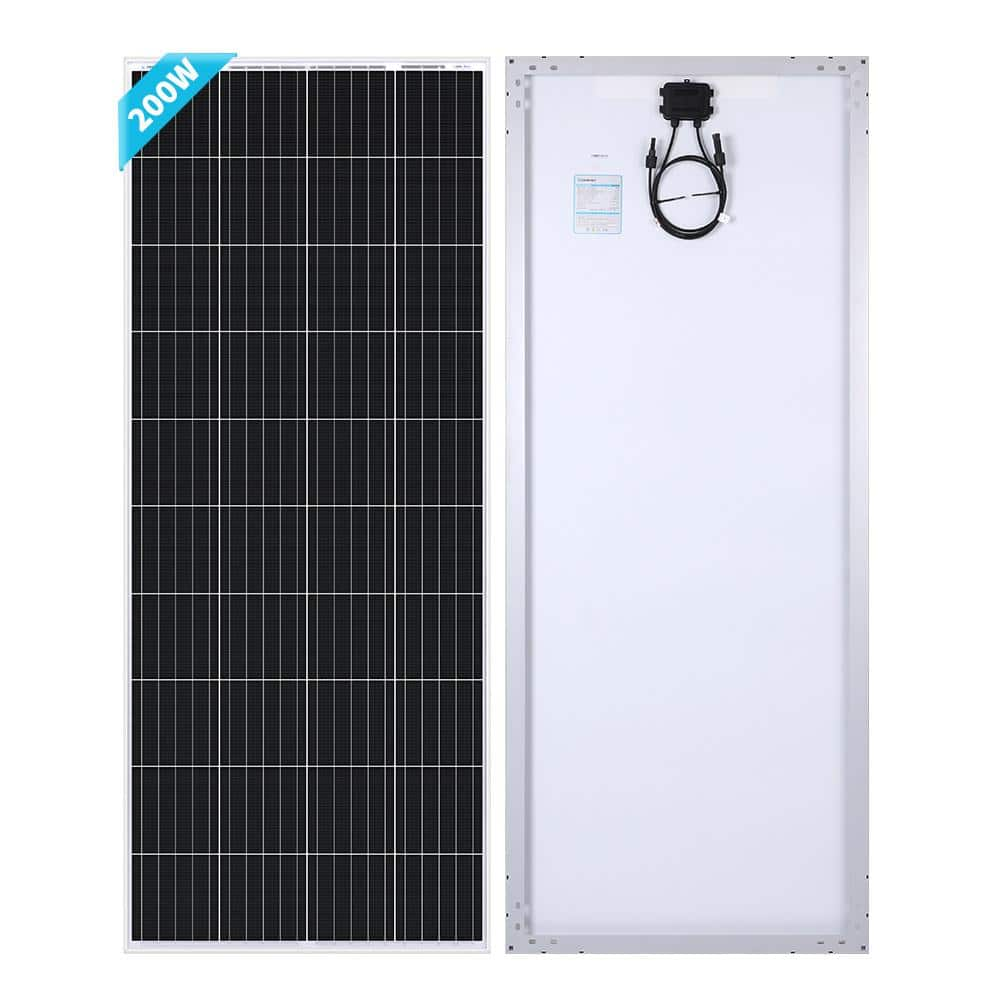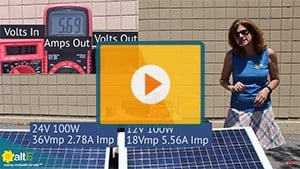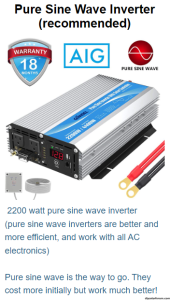You are using an out of date browser. It may not display this or other websites correctly.
You should upgrade or use an alternative browser.
You should upgrade or use an alternative browser.
Renogy DC DC Charger w/ MPPT
- Thread starter Will Prowse
- Start date
Royal-PITA
New Member
where did you attach the IGN cable to on your vehicle? I'm kinda confused by this as I don't have anything called a "smart ignition circuit" that the instructions call for. Closest things I see in my truck fuse box (2015 Canyon) are "Fuel Module Ignition" "Miscellaneous 1 Ignition" "Miscellaneous 2 Ignition"Update with respect to my previous post regarding the DCC50s hardly charging at all from alternator.
Connecting the IGN (ignition sense) wire made all the difference in the world. Despite the alternator outputting below 13.5V, the charge current now goes up to 50A as it should. Disconnected the IGN sense wire and the charge current is down to maybe 6A.
Bottom line: if you have a non-smart charger and the DCC50s does not charge adequately, connecting the ignition sense wire helps.
Note: this is in direct violation of the installation instructions. Do this at your own risk.
Hedges
I See Electromagnetic Fields!
- Joined
- Mar 28, 2020
- Messages
- 20,696
I think any circuit that comes on when engine is running would be good. This is so it doesn't charge off starter battery when engine is stopped.
Preferably something that turns off when cranking. My cars, the radio turns off during cranking.
One of your miscellaneous may do, check them with light or meter while cranking.
Preferably something that turns off when cranking. My cars, the radio turns off during cranking.
One of your miscellaneous may do, check them with light or meter while cranking.
First time ever working with solar or electrical so bare with me.
I am currently trying to build out my campervan Solar system and have a couple questions. I got trigger happy awhile ago and bought the Renogy DC DC Charger w/ MPPT but I'm not sure If I can fully use all of my roof space with this charge controller.
I would like to use two 200w solar panels and two 50w solar panels (details below) because it will use every inch of my van roof space that I have left. My question is can I use a 4-1 MC4 branch connector to connect these solar panels together? If I did my calculations right I'll be at 28.48 watts but the MC4 branch connector has a max current rating of 30A. I have read about colder temperatures increasing your solar panel voltage output, will the amps increase also? I live in Phoenix, Arizona but love to chase Snow. I have tried to read this entire thread and remember someone stating to splice 8 or 10 gauge wire between the mppt and branch adapter depending on the distance because the MC4 connector can't handle more than 20 amps. If I can use a 4-1 branch connector can I twist/break off the MC4 output side of the branch connector and splice in a 8 gauge wire or is there an easier way of doing it?
Option 2- If the 4-1 branch connector is not an option I have been reading about combiner boxes, any recommendation on outdoor Vehicle/rooftop mounted combiner boxes?
Option 3- give up on the extra two 50w panels and only use two 200W solar panels with a 22.94 max amp output.
200W solar panel
Vmp 18.6V
Imp 10.76A
Voc 21.8V
ISC 11.47A
50W solar panel
Vmp 19.06V
Imp 2.63A
Voc 21.82V
Isc 2.77A
I am currently trying to build out my campervan Solar system and have a couple questions. I got trigger happy awhile ago and bought the Renogy DC DC Charger w/ MPPT but I'm not sure If I can fully use all of my roof space with this charge controller.
I would like to use two 200w solar panels and two 50w solar panels (details below) because it will use every inch of my van roof space that I have left. My question is can I use a 4-1 MC4 branch connector to connect these solar panels together? If I did my calculations right I'll be at 28.48 watts but the MC4 branch connector has a max current rating of 30A. I have read about colder temperatures increasing your solar panel voltage output, will the amps increase also? I live in Phoenix, Arizona but love to chase Snow. I have tried to read this entire thread and remember someone stating to splice 8 or 10 gauge wire between the mppt and branch adapter depending on the distance because the MC4 connector can't handle more than 20 amps. If I can use a 4-1 branch connector can I twist/break off the MC4 output side of the branch connector and splice in a 8 gauge wire or is there an easier way of doing it?
Option 2- If the 4-1 branch connector is not an option I have been reading about combiner boxes, any recommendation on outdoor Vehicle/rooftop mounted combiner boxes?
Option 3- give up on the extra two 50w panels and only use two 200W solar panels with a 22.94 max amp output.
200W solar panel
Vmp 18.6V
Imp 10.76A
Voc 21.8V
ISC 11.47A
50W solar panel
Vmp 19.06V
Imp 2.63A
Voc 21.82V
Isc 2.77A
Check the maximum voltage input on that device. That's a number you don't want to exceed.
If you used a 4-into-1 connector then all four panels would be in parallel and the Isc amps add up and will be 28.48. That may exceed the max amps the device can work with. Usually amps/watts aren't limited, but the volts are.
I would connect the two 200 watt panels in parallel and then into the DC-DC/MPPT device. If you still want to use the other two panels, use a second dedicated MPPT controller.
If you used a 4-into-1 connector then all four panels would be in parallel and the Isc amps add up and will be 28.48. That may exceed the max amps the device can work with. Usually amps/watts aren't limited, but the volts are.
I would connect the two 200 watt panels in parallel and then into the DC-DC/MPPT device. If you still want to use the other two panels, use a second dedicated MPPT controller.
Tomthumb62
Solar Wizard
- Joined
- Sep 25, 2022
- Messages
- 1,871
Check the maximum voltage input on that device. That's a number you don't want to exceed.
From the Renogy website:
Max. Solar Input Voltage:25V
those 200W panels will surely exceed 25V. If you exceed that number, poof the magic smoke comes out of your device and it must be replaced. This would happen very quickly if you hooked up your 200W panels.I would like to use two 200w solar panels and two 50w solar panels (details below) because it will use every inch of my van roof space that I have left.
Now you could ditch those and have up to 6x100W according to renogy;
Max. Solar Input Power:660W @ 50A
As for combing 100W panels with your existing 50W ones, that is a rookie answer I can’t recall at the moment. If you connect in parallel, I believe there is some loss of power and you cannot connect unmatched panels in series.
If I connected the 200w solar panels in series wouldn't I be fine? Renogy's 100W solar panels have a higher Voc and Vmc?those 200W panels will surely exceed 25V. If you exceed that number, poof the magic smoke comes out of your device and it must be replaced. This would happen very quickly if you hooked up your 200W panels.
Now you could ditch those and have up to 6x100W according to renogy;
Max. Solar Input Power:660W @ 50A
Renogy 100w
Voc 24.3
Vmp 20.4
My 200w
Voc 21.8
Vmp 18.6
Maybe I'm missing something, I am new to this
Last edited:
Tomthumb62
Solar Wizard
- Joined
- Sep 25, 2022
- Messages
- 1,871
Then you don’t have true 200W panels. Real 200W will have a Voc of 30-40V more or less. What you probably have are two 100W panels connected in parallel. Have you tested the voltage with a multimeter with the panel in direct sun? If you intend to use this Renogy dcdc MPPT, then you’ll want to confirm what the actual output voltage is, before connecting it up.If I connected the 200w solar panels in series wouldn't I be fine? Renogy's 100W solar panels have a higher Voc and Vmc?
Renogy 100w
Voc 24.3
Vmp 20.4
My 200w
Voc 21.8
Vmp 18.6
Maybe I'm missing something, I am new to this
And you’re correct, those 100W panels are way way too close on the Voc to use in your system. A bit of cool or cold weather (Panet voltage can increase significantly in such conditions) and poof, out comes the magic smoke from your dcdc MPPT.
Every 12v solar panel I have seen does not go up to 30-40V no matter the watts, are you thinking of 24v solar panels?Then you don’t have true 200W panels. Real 200W will have a Voc of 30-40V more or less. What you probably have are two 100W panels connected in parallel. Have you tested the voltage with a multimeter with the panel in direct sun? If you intend to use this Renogy dcdc MPPT, then you’ll want to confirm what the actual output voltage is, before connecting it up.
And you’re correct, those 100W panels are way way too close on the Voc to use in your system. A bit of cool or cold weather (Panet voltage can increase significantly in such conditions) and poof, out comes the magic smoke from your dcdc MPPT.
Thanks for the reply HKTKDCheck the maximum voltage input on that device. That's a number you don't want to exceed.
If you used a 4-into-1 connector then all four panels would be in parallel and the Isc amps add up and will be 28.48. That may exceed the max amps the device can work with. Usually amps/watts aren't limited, but the volts are.
I would connect the two 200 watt panels in parallel and then into the DC-DC/MPPT device. If you still want to use the other two panels, use a second dedicated MPPT controller.
I should be fine on both the volts (max input for the device is 25V) and Amps (max input for the device is 50A) If I did my math right on a Temperature Coefficient calculator my max volts should be around 23.86. Are you saying to ditch the two 50W panels because I will be over amps or voltage on my device or because of the MC4 branch connector?
Tomthumb62
Solar Wizard
- Joined
- Sep 25, 2022
- Messages
- 1,871
Correct, but no one makes 12v 200W panels, not to my knowledge. They’ll parallel two 100W 12V panels to get to 200W. It’s not a panel, but panels. Marketing can be confusing sometimes.Every 12v solar panel I have seen does not go up to 30-40V no matter the watts, are you thinking of 24v solar panels?
Hedges
I See Electromagnetic Fields!
- Joined
- Mar 28, 2020
- Messages
- 20,696

Renogy 200-Watt 12-Volt Monocrystalline Solar Panel for Off Grid Large System Residential Commercial House Cabin Sheds Rooftop RSP200D-G1 - The Home Depot
The Renogy 200 Watt 12 Volt Monocrystalline Solar Panel is one of the main components for any solar power (PV) system. The panel includes solar connector leads that extend from the junction box affixed
www.homedepot.com
Hedges
I See Electromagnetic Fields!
- Joined
- Mar 28, 2020
- Messages
- 20,696
From the Renogy website:
Max. Solar Input Voltage:25V
those 200W panels will surely exceed 25V. If you exceed that number, poof the magic smoke comes out of your device and it must be replaced. This would happen very quickly if you hooked up your 200W panels.
"Open Circuit Voltage: 27 V"
Thanks for the reply HKTKD
I should be fine on both the volts (max input for the device is 25V) and Amps (max input for the device is 50A) If I did my math right on a Temperature Coefficient calculator my max volts should be around 23.86. Are you saying to ditch the two 50W panels because I will be over amps or voltage on my device or because of the MC4 branch connector?
Mixing panels of different voltage/amperage is not ideal. Yes, you can do it, but the end result may not be optimal. That's why I said use two different solar charge controllers. One for the 200 watt panels and one for the 50 watt panels.
Check out this link that covers mismatched panels:

How to wire mismatched solar panels. Wire in parallel or in series?
Video series testing wiring mismatched solar panels in parallel vs. wiring in series to maximize solar PV output with an MPPT charge controller.
 www.altestore.com
www.altestore.com
Tomthumb62
Solar Wizard
- Joined
- Sep 25, 2022
- Messages
- 1,871
Thanks, Hedges. I stand corrected then.
Renogy 200-Watt 12-Volt Monocrystalline Solar Panel for Off Grid Large System Residential Commercial House Cabin Sheds Rooftop RSP200D-G1 - The Home Depot
The Renogy 200 Watt 12 Volt Monocrystalline Solar Panel is one of the main components for any solar power (PV) system. The panel includes solar connector leads that extend from the junction box affixedwww.homedepot.com
Hi!! Following Will's blueprint, I ordered the Renology dual charger and LiTime battery. I'm not adding solar at this point, maybe next year. My question is about the Shore Power part of the charging the battery... Is the "Pure Sine Wave Inverter" part of the conversion/charge products needed? Or is that for Solar? I mostly boondock for 1-2 nights between driving, but there are times I choose a campground with 30A hookups.
Hi!! Following Will's blueprint, I ordered the Renology dual charger and LiTime battery. I'm not adding solar at this point, maybe next year. My question is about the Shore Power part of the charging the battery... Is the "Pure Sine Wave Inverter" part of the conversion/charge products needed? Or is that for Solar? I mostly boondock for 1-2 nights between driving, but there are times I choose a campground with 30A hookups.
Please provide the exact product you're referring to. A link would help.
If it's just an inverter, then it won't charge the batteries. For charging from shore power, you need an AC-DC converter. To simplify the system an inverter/charger, which combines an inverter and a converter, is nice to have.
Please provide the exact product you're referring to. A link would help.
If it's just an inverter, then it won't charge the batteries. For charging from shore power, you need an AC-DC converter. To simplify the system an inverter/charger, which combines an inverter and a converter, is nice to have.
I purchased the Renology "DCC30S 12V 30A Dual Input DC-DC On-Board Battery Charger with MPPT SKU: RBC30D1S-US" as recommended in Will's blueprint for a 400W solar system https://www.mobile-solarpower.com/simplified-400-watt-fewer-wires-and-alternator-charging.html
The blueprint suggests a pure sine wave inverter: https://amzn.to/3sUZ3Rb
Is the inverter for when you add solar? Or it's needed regardless? @Will Prowse --is there a converter/charger you recommend?

Inverter outputs ac voltage for appliances.I purchased the Renology "DCC30S 12V 30A Dual Input DC-DC On-Board Battery Charger with MPPT SKU: RBC30D1S-US" as recommended in Will's blueprint for a 400W solar system https://www.mobile-solarpower.com/simplified-400-watt-fewer-wires-and-alternator-charging.html
The blueprint suggests a pure sine wave inverter: https://amzn.to/3sUZ3Rb
Is the inverter for when you add solar? Or it's needed regardless? @Will Prowse --is there a converter/charger you recommend?
View attachment 180617
The dcdc charger powers the battaries from the vehucle cgargibg system.
If you want to charge batteries from shore power, you need either a battery charger, or an inverter/charger.
Hedges
I See Electromagnetic Fields!
- Joined
- Mar 28, 2020
- Messages
- 20,696
Under "inverters", Will suggests for pricer options a Victron inverter/charger ($1246)

 www.currentconnected.com
www.currentconnected.com
For up to $200 (25A), here's a charger only:

 www.currentconnected.com
www.currentconnected.com

Victron 12V MultiPlus-II 3kVA 2x120V Inverter/Charger | Current Connected
Power, adaptability, and efficiency combined - the MultiPlus-II 2x120V Inverter delivers unparalleled performance for your energy system needs.
 www.currentconnected.com
www.currentconnected.com
For up to $200 (25A), here's a charger only:

Victron Blue Smart 12V IP65 Battery Charger | Current Connected
Victron IP65 Charger: Recovers fully-depleted LiFePO4 Batteries. Can be used as a UPS. Bluetooth for adjusting charging set-points and monitoring status.
 www.currentconnected.com
www.currentconnected.com
Similar threads
- Replies
- 16
- Views
- 516
- Replies
- 6
- Views
- 268
- Replies
- 1
- Views
- 585
- Replies
- 8
- Views
- 792
- Replies
- 11
- Views
- 315


